Understanding Clinical Trials
What is a clinical trial?
Clinical trials are research studies in humans designed to study if an experimental therapy or treatment works. Clinical trials are the final step in a long process that begins with research in a lab. Much of what we know about disease progression, including effective therapies and treatments, is the result of past clinical trials. Clinical trials can be used to determine whether a treatment is safe and how well the new treatment works in particular people.
Watch our Introduction to Clinical Trials Video to get started!
Who can participate in a clinical trial?
Each trial or study has rules about who can or cannot be in the study. These rules are called eligibility criteria and they describe features that must be shared by all the people in the study. The eligibility criteria, also called the inclusion and exclusion criteria, differ from study to study.
Inclusion criteria help make sure everyone in the trial is as similar as possible. This helps researchers understand the results from the study better since there will be fewer differences between people in the study.
The exclusion criteria help keep people safe by excluding those who may be at especially high risk if they were in the study.
It is important to note that inclusion and exclusion criteria are not used to reject people personally. Instead, the criteria are used to identify appropriate participants and keep them safe. The criteria help ensure that researchers will be able to answer the questions they plan to study.
Before joining a clinical trial, a participant must go through a screening process with the study team to determine if they meet the eligibility criteria. Some trials seek participants with illnesses or conditions to be studied in the trial, while others need healthy participants.
Watch our Trial Criteria video for more information.
What happens during a clinical trial?
The clinical trial process depends on the kind of trial being conducted. The clinical trial team (or study team) includes doctors and nurses, as well as, social workers and other health care professionals. They check the health of the participant at the beginning of the trial, give specific instructions for participating in the trial, monitor the participant carefully during the trial, and stay in touch after the trial is completed.
Some clinical trials involve more lab tests, procedures, and doctor visits than the participant would normally have for an illness or condition. For all types of trials, the participant will always work closely with the study team at their trial site. Clinical trial participation is most successful when the protocol (the required treatments/labs/procedures) is carefully followed and there is frequent contact with the study team.
You can learn more at Types & Phases of Clinical Trials.
What is informed consent?
Informed consent is a process. The process involves learning key facts about a clinical trial by listening and asking questions of the study team and other professionals before deciding whether or not to participate. The informed consent process is meant to help people understand the study goals, process, risks, and benefits.
When you first meet with the study team, they will provide you with information about the study and give you a chance to ask questions. Then the research team provides an informed consent document that includes details about the study, such as its purpose, duration, required procedures, risks, potential benefits, and key contacts. The participant then decides whether or not to sign the document. This informed consent process should continue throughout the study to continually provide as much information as possible for participants.
Things to keep in mind:
- You do not have to sign the consent form on your first visit. You can take it home to review it with your family and with your local doctor.
- You should sign a consent form before you do any study assessments.
- If your child is participating, and he or she is 7 years old or older, the study team may ask your child to sign an assent form. The assent form has similar information as the consent form, but it is explained in easier terms. As a parent, you can use the assent form to help your child understand the purpose of the study and what will happen during the study.
- Even after you sign the consent form, you do not have to participate in the study. You can change your mind at any time and withdraw from the study. Although, in some studies, follow-up visits may be needed to monitor your or your child’s health.
What are the benefits and risks of participating in a clinical trial?
Each clinical trial offers its own potential benefits and risks, but most have some things in common.
Benefits
Being in a clinical trial can allow a person to:
- Play an active role in their own health care
- Gain access to new research treatments before they are widely available
- Obtain expert medical care at leading health care facilities during the trial
- Help others by contributing to medical research
Risks
Clinical trials are experiments and each trial has its owns risks. Some potential risks are:
- Side effects which may be unpleasant, serious, or even life-threatening
- The experimental treatment may not be effective for everyone
- Your time and attention may be strained due to study visits, treatments, hospital stays, etc.
- Participating in a trial may be emotionally difficult
- Participating in a trial may exclude you from participating in future trials
Watch our Benefits and Risks videos to learn more.
How is the safety and privacy of the participant protected?
There are many things that the study team does to protect the safety, privacy, and confidentiality of everyone in the study. This includes identifying people in the study by number, rather than name, in the study databases to help protect privacy. This practice is called de-identification. If anything serious goes wrong during a study, the researchers have to tell the Institutional Review Board (IRB) to help protect the participant’s safety. The IRB can stop a study if the researchers are not following the study protocol, or if the trial is causing unexpected harm to people, or if the new treatment is obviously working (so that the treatment can be made available to everyone).
Some clinical trials, especially Phase 3 trials, use a Data and Safety Monitoring Board (DSMB). A DSMB is an independent group made up of statisticians, doctors, and patient advocates. The DSMB tries to make sure the study risks are as small as possible, that the study data is complete, and that a trial is stopped if there are concerns about safety.
Who sponsors clinical trials?
Clinical trials can be sponsored or funded by a variety of groups or individuals. These include doctors, medical institutions, foundations, voluntary/support groups, pharmaceutical companies, and federal agencies such as the National Institutes of Health (NIH) or the Department of Defense (DOD). Clinical trials can take place in different locations, but often take place at hospitals, universities, doctors’ offices, or community clinics.
Where can I find out more information about clinical trials?
Here are different ways you can learn more about clinical trials:
- Watch the videos in our Clinical Trial Video Library
- Talk with your clinical care team
- Participate in The Duchenne Registry
- Use the Trial Finder Tool
- Visit www.clinicaltrials.gov





